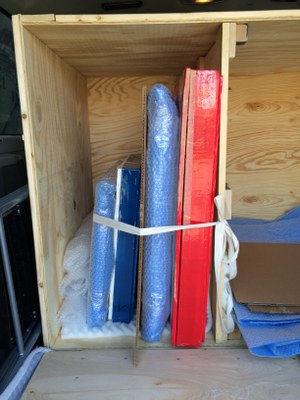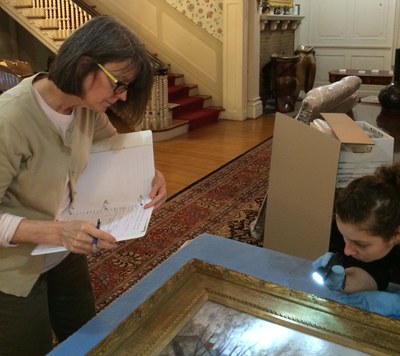
Purchase Tickets
On the Road with T.C. Steele
April 5, 2016

In preparation for Indiana Impressions: The Art of T.C. Steele, IHS conservators took to the roads of central Indiana to pick up the 43 paintings on loan from our generous donors. We trained to work with books and paper documents, so this was an opportunity to adapt our knowledge of how to care for fragile historic documents and apply it to paintings, which pose their own unique set of challenges for handling and storage. For starters, they’re much bigger and heavier than most of the items we typically work with! This project required a lot of innovation, creative problem solving on-the-fly, and channeling our inner Tim Gunn to “make it work.”
Our first step was to retrofit the IHS cargo van so that it could safely accommodate up to seven paintings at one time. Vibrations caused by the movement of the van can damage the paint layers and ornate frames, so we needed to minimize bumps and give the paintings a smooth ride. We constructed a crate to fit just between the van’s wheel wells. The bottom of the crate is lined with foam and the wrapped paintings are secured to the center support fence with twill tape. Paintings too large for the crate were placed on moving blankets and secured to the back bench seat with long strips of muslin. While most of the paintings could safely travel vertically, a small handful of the paintings needed to be transported flat, due to unstable paint layers or decorative frame elements.
With the crate in place and our supplies packed, it was time to hit the road. Since we were going into private homes to pick up the paintings, we couldn’t predict ahead of time how much space we’d have to work in or what obstacles we might encounter. Would we have to navigate around other valuable household items? Would there be curious dogs and cats underfoot? Every situation was different, but all of the donors were welcoming and appreciated the care taken with their precious paintings.

Upon arrival at our destination, we met the donors, identified the paintings, and set up a temporary workspace. The lid of the crate doubled as a portable tabletop that, when placed on a pair of sawhorses, gave a us a sturdy work surface on which to examine and wrap the paintings. We did quick condition surveys of each painting and frame on site, noting areas of damage or potential weakness.
We then wrapped the paintings in a “softpack.” The paintings were placed between two pieces of corrugated cardboard cut to the outer dimensions of the frame, then wrapped with paper-lined bubble wrap secured with packing tape and cling film. Orange stickers indicated the top edge and face of the painting.
Driving at a leisurely pace with hazard lights flashing, we got to know what felt like every pothole in central Indiana. We also discovered some hidden cultural gems, like the Richmond Art Museumand the Haan Museumin Lafayette. And we got lucky? only one trip happened during a rainstorm and we got to travel through Bartholomew County just as the daffodils began to bloom.
By the time we reached our last pick-up site, we’d finally figured out all of the tricks and techniques for making this a smooth process … which will come in handy when we have to do it all again in reverse this August to return the paintings.
_______________________________








